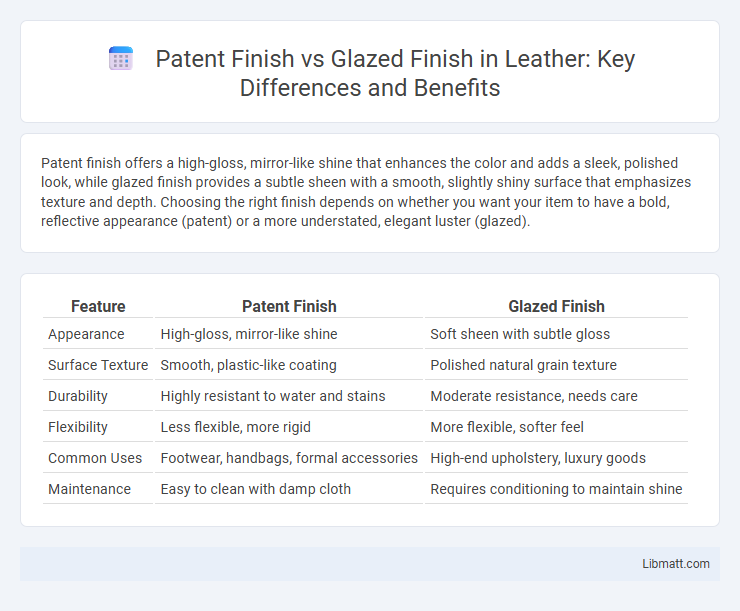Patent finish offers a high-gloss, mirror-like shine that enhances the color and adds a sleek, polished look, while glazed finish provides a subtle sheen with a smooth, slightly shiny surface that emphasizes texture and depth. Choosing the right finish depends on whether you want your item to have a bold, reflective appearance (patent) or a more understated, elegant luster (glazed).
Table of Comparison
| Feature | Patent Finish | Glazed Finish |
|---|---|---|
| Appearance | High-gloss, mirror-like shine | Soft sheen with subtle gloss |
| Surface Texture | Smooth, plastic-like coating | Polished natural grain texture |
| Durability | Highly resistant to water and stains | Moderate resistance, needs care |
| Flexibility | Less flexible, more rigid | More flexible, softer feel |
| Common Uses | Footwear, handbags, formal accessories | High-end upholstery, luxury goods |
| Maintenance | Easy to clean with damp cloth | Requires conditioning to maintain shine |
Introduction to Patent Finish and Glazed Finish
Patent finish features a high-gloss, mirror-like surface achieved through multiple layers of lacquer or polyurethane, enhancing the shoe's visual appeal and making it highly reflective. Glazed finish is created by friction polishing with a special cloth or brush, producing a subtle, shiny surface that offers a more natural leather look while maintaining durability. Both finishes are used primarily in footwear and leather goods to provide distinct aesthetic effects and surface protection.
Defining Patent Finish: Key Characteristics
Patent finish is a high-gloss, mirror-like surface achieved through a multi-step process involving polishing and lacquering, often used in luxury leather goods and footwear. Its key characteristics include exceptional shine, smooth texture, and enhanced water resistance, making it visually striking and durable. Unlike glazed finishes, which rely on heat and pressure to create a smooth surface, patent finishes use synthetic coatings to maintain intensity and long-lasting brilliance.
Understanding Glazed Finish: Features Explained
A glazed finish features a translucent layer that enhances surface durability while providing a subtle shine, creating a smooth and reflective appearance. This finish improves resistance to stains and scratches by sealing the material beneath, making it ideal for ceramics and tiles. Unlike patented finishes with added polymer layers, glazed finishes rely on fired-on glassy coatings for long-lasting protection and aesthetic appeal.
Differences Between Patent Finish and Glazed Finish
Patent finish is characterized by a high-gloss, shiny surface achieved through a special coating process, commonly applied to leather shoes for a sleek, mirror-like appearance. Glazed finish, on the other hand, is created by rubbing leather with a smooth tool to produce a hard, polished surface that enhances durability and gives a subtle sheen without the intense shine of patent leather. The main difference lies in patent finish's synthetic, reflective coating versus glazed finish's manual polishing technique, resulting in distinct textures and levels of glossiness.
Manufacturing Processes: Patent vs. Glazed
Patent finish involves applying multiple layers of coating to leather, which are then polished and buffed to create a high-gloss, smooth surface using a controlled heat and pressure process. Glazed finish, on the other hand, is achieved by pressing the leather surface against a heated roller or cylinder, producing a shiny, smooth texture without additional coatings. Understanding these manufacturing processes helps you choose the right finish based on durability, appearance, and intended use.
Applications in Various Industries
Patent finish is widely used in fashion and luxury goods industries due to its high-gloss, reflective surface that enhances aesthetic appeal, commonly seen in footwear, handbags, and apparel. Glazed finish finds applications in ceramics, pottery, and tile manufacturing, providing a smooth, shiny, and protective coating that increases durability and stain resistance. Both finishes are integral in automotive and furniture industries, where patent provides a sleek, polished look, while glazed coatings offer resistant surfaces suitable for high-wear environments.
Durability and Maintenance Comparison
Patent finish offers a high-gloss surface that enhances durability by providing resistance against scratches and water damage, making it easier to maintain with simple cleaning. Glazed finish, while also glossy, tends to be more prone to developing cracks or chips over time due to its thinner protective layer, requiring more careful upkeep and occasional refinishing. Both finishes need regular cleaning, but patent finishes generally demand less frequent maintenance to preserve their shine and structural integrity.
Aesthetic Appeal: Visual Impact of Each Finish
Patent finish offers a high-gloss, mirror-like surface that enhances the visual impact with vibrant shine and smooth reflections, making footwear or accessories stand out dramatically. Glazed finish provides a subtler, polished look with a soft luster that adds depth and sophistication without the intense shine of patent leather. Your choice depends on whether you prefer a bold, eye-catching statement or an elegant, understated aesthetic.
Cost Considerations and Market Trends
Patent finish typically incurs higher production costs due to the complex polishing and coating processes required to achieve its high-gloss, mirror-like surface, making it a premium option in footwear and fashion industries. In contrast, glazed finish offers a more cost-effective alternative by providing a slightly less reflective shine through simpler techniques, appealing to mid-range market segments seeking style and affordability. Market trends indicate a growing consumer preference for patent finishes in luxury goods, while glazed finishes maintain steady demand in everyday apparel due to their balance of aesthetic appeal and budget-conscious pricing.
Choosing the Right Finish for Your Project
Patent finish offers a high-gloss, mirror-like surface ideal for modern, sleek designs, enhancing color vibrancy and ease of cleaning. Glazed finish provides a subtle sheen with a protective layer that highlights texture and depth, suitable for traditional or rustic aesthetics. Selecting the right finish depends on desired visual impact, durability requirements, and the specific environmental conditions of your project.
Patent finish vs glazed finish Infographic

 libmatt.com
libmatt.com